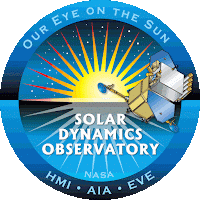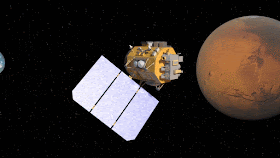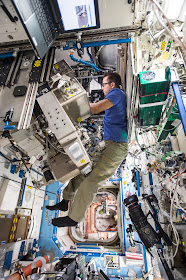
Bigelow Aerospace logo / United Launch Alliance (ULA) logo.
Oct. 21, 2017
Bigelow Aerospace and United Launch Alliance (ULA) are working together to launch a B330 expandable module on ULA’s Vulcan launch vehicle. The launch would place a B330 outfitted module in Low Lunar Orbit by the end of 2022 to serve as a lunar depot.
B330 Habitat in Low Lunar Orbit
“We are excited to work with ULA on this lunar depot project,” said Robert Bigelow, president of Bigelow Aerospace. “Our lunar depot plan is a strong complement to other plans intended to eventually put people on Mars. It will provide NASA and America with an exciting and financially practical success opportunity that can be accomplished in the short term. This lunar depot could be deployed easily by 2022 to support the nation’s re-energized plans for returning to the Moon.
"This commercial lunar depot would provide anchorage for significant lunar business development in addition to offering NASA and other governments the Moon as a new exciting location to conduct long-term exploration and astronaut training.”
B330 A Fully Autonomous Stand -Alone Space Station description
The B330 would launch to Low Earth Orbit on a Vulcan 562 configuration rocket, the only commercial launch vehicle in development today with sufficient performance and a large enough payload fairing to carry the habitat. Once the B330 is in orbit, Bigelow Aerospace will outfit the habitat and demonstrate it is working properly. Once the B330 is fully operational, ULA’s industry-unique distributed lift capability would be used to send the B330 to lunar orbit. Distributed lift would also utilize two more Vulcan ACES launches, each carrying 35 tons of cryogenic propellant to low Earth orbit. In LEO, all of the cryogenic propellant would be transferred to one of the Advanced Cryogenic Evolved Stage (ACES). The now full ACES would then rendezvous with the B330 and perform multiple maneuvers to deliver the B330 to its final position in Low Lunar Orbit.
Image above: Radiation Protection and Debris Shielding. Terrestrial test data and on-orbit validation suggest that a fully outfitted B330 spacecraft will have robust debris and radiation shielding.
“We are so pleased to be able to continue our relationship with Bigelow Aerospace,” said Tory Bruno, ULA’s president and CEO. “The company is doing such tremendous work in the area of habitats for visiting, living and working off our planet and we are thrilled to be the ride that enables that reality.”
Actual Bigelow module (BEAM) test on International Space Station
Bigelow Aerospace is a destination-oriented company with a focus on expandable systems for use in a variety of space applications. These NASA heritage systems provide for greater volume, safety, opportunity and economy than the aluminum alternatives.
Launcher's, Modularity & Scalability (not to scale)
The B330 is a standalone commercial space station that can operate in low Earth orbit, cislunar space and beyond. A single B330 is comparable to one third of the current pressurized volume of the entire International Space Station. Bigelow Aerospace is developing two B330 commercial space station habitats that will be ready for launch any time after 2020.
Related links:
Bigelow Expandable Activity Module (BEAM): https://www.nasa.gov/content/bigelow-expandable-activity-module
International Space Station (ISS): https://www.nasa.gov/mission_pages/station/main/index.html
Commercial Space: http://www.nasa.gov/exploration/commercial/index.html
For more information on Bigelow Aerospace visit http://www.bigelowaerospace.com/
For more information on United Launch Alliance (ULA), visit the ULA website at http://www.ulalaunch.com/
Images, Videos, Text, Credits: ULA/Bigelow Aerospace/NASA.
Greetings, Orbiter.ch















































